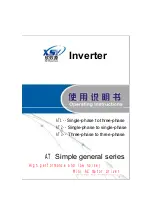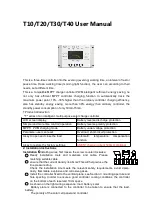
4-87
PID Fine Tuning
All PID control parameters are related to each other and require to be adjusted to the appropriate values.
Therefore, the procedure achieving the minimum steady-state is shown as following:
(1) Increase or decrease the proportion (P) gain until the system is stable using the smallest possible control
change.
(2) The integral (I) reduces the system stability which is similar to increasing the gain. Adjust the integral time so
that the highest possible proportional gain value can be used without affecting the system stability. An
increase in the integral time reduces system response.
(3) Adjust the differential time if necessary to reduce overshoot on startup. The acceleration / deceleration time
can also be used for the same purpose.
Fine-tuning PID control parameters:
(1) Reduce overshoot
Output
Before
After
t
In case overshoot occurs, reduce the derivative time
(D) and increase the integral time (I).
(2) Stabilize PID control
Output
Before
After
t
To quickly stabilize the PID control, reduce the
integral time (I) and increase the differential time (D)
in case overshoot occurs.
(3) Reduce long-period oscillation
Output
Before
After
t
Adjust the integral time (I) in case of long-periodical
system oscillation.
(4) Reduce short-period oscillation
Output
Before
After
t
Adjusting the differential time (D) and proportional (P)
gain when experiencing short-periodical oscillation.
Downloaded from Dealers Industrial Equipment -- Visit
















































